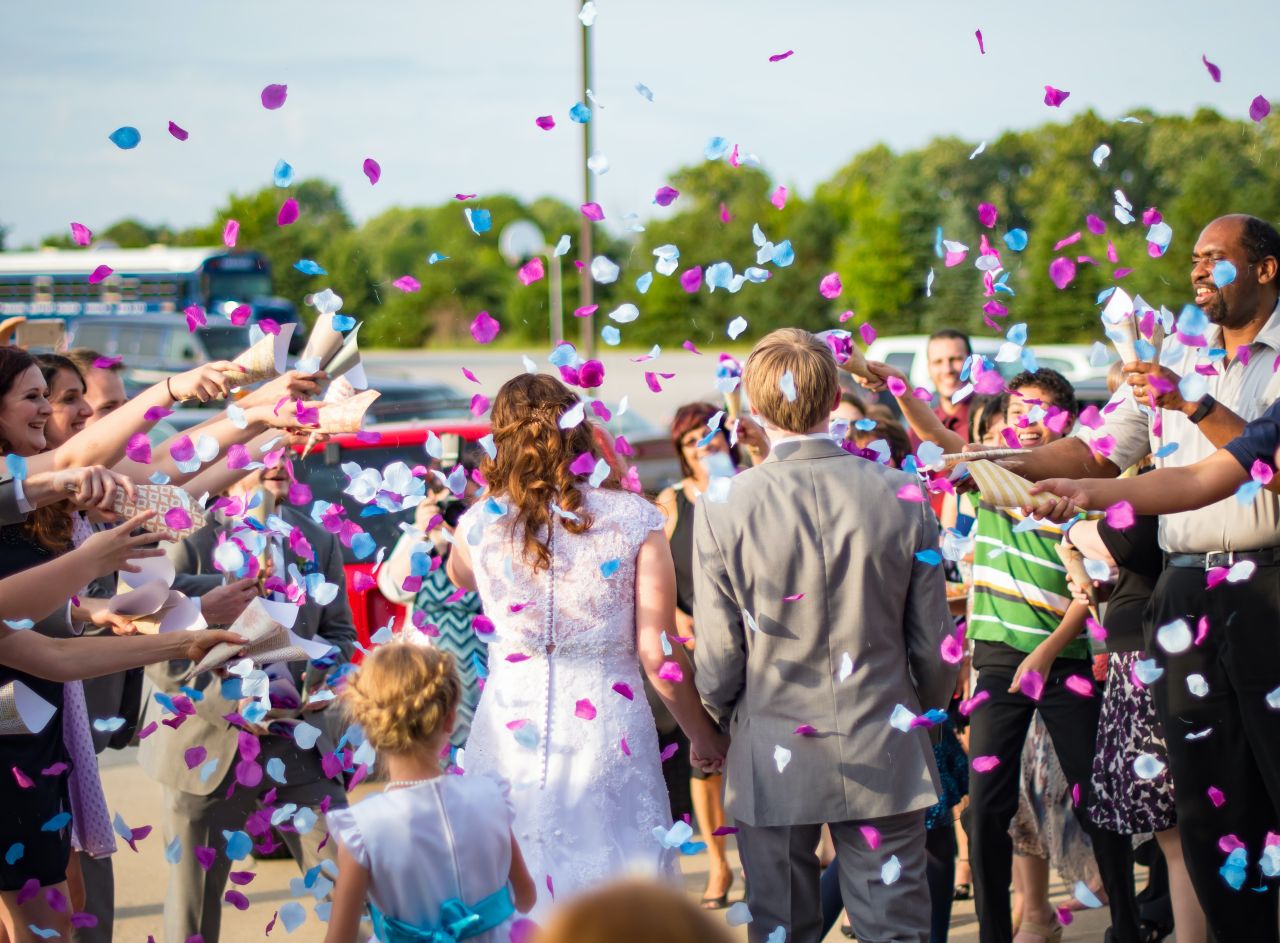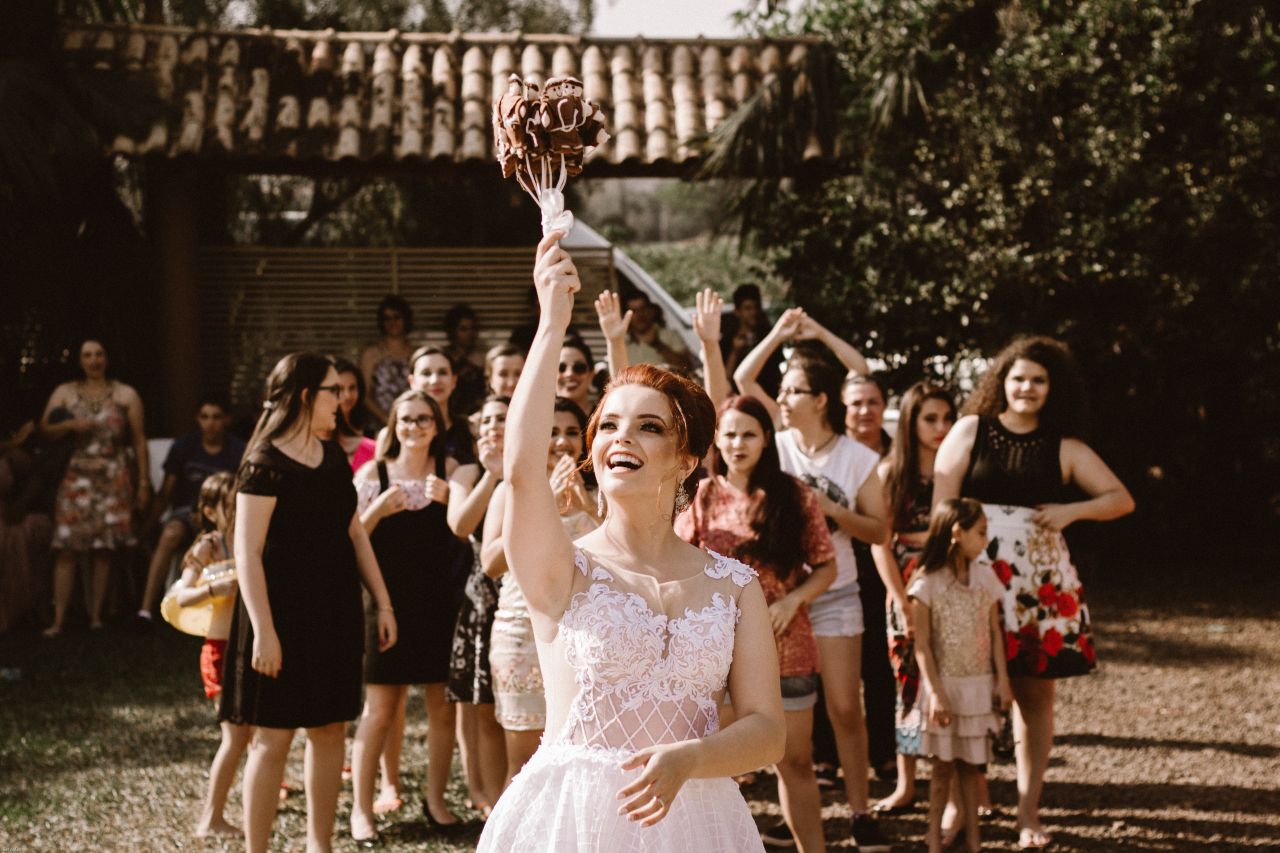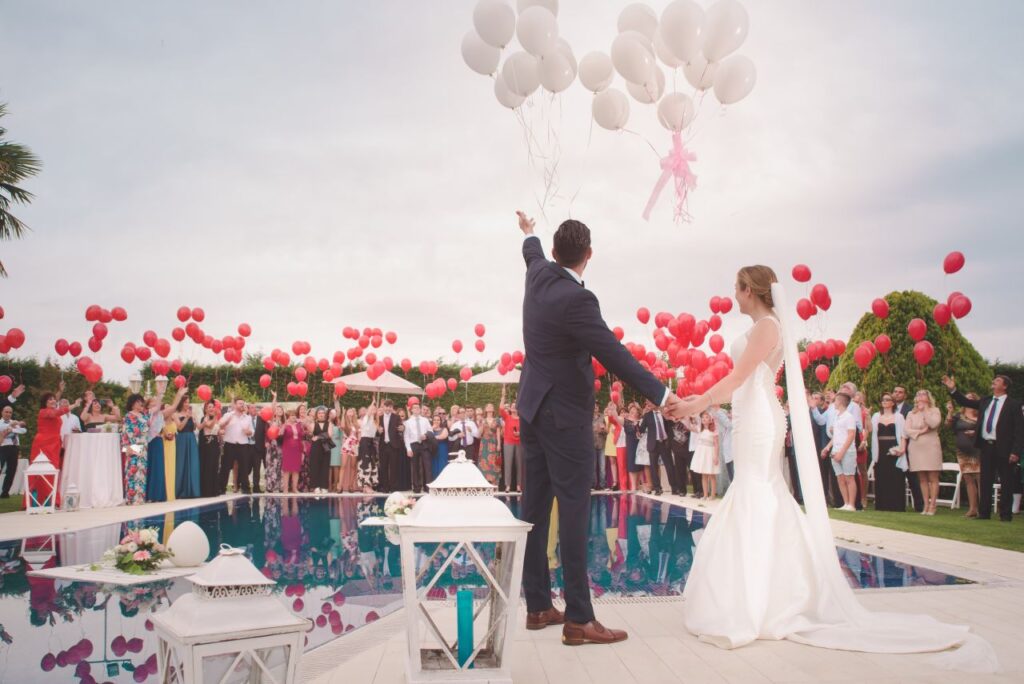The foundation of many weddings is rooted in time-honored customs, but as each new generation joins two lives together, some of those traditions fall by the wayside. The millennial generation, which currently outnumbers the baby boomers, is defined by its preference for unique weddings that reflect the individuality of the couple.
The goal of each couple planning the classic, old-fashioned wedding is to make something that represents the union of two people and their respective cultures on the most momentous day of their lives. Guests and family members are typically polled to ensure that the wedding follows all the norms of the culture.
Know this: No two wedding ceremonies are the same before you begin planning the order of events. Each couple has their own special blend of elements, including the officiant, speeches, ring exchange, recessional, and more, even if some couples share the same vows or deep dip for the kiss. So, here's a typical wedding ceremony timeline to give you some ideas, but don't feel like you have to follow it exactly or include everything.
When two people exchange marriage vows, they are participating in a ceremony and its related rites. Though at its core a celebration of love and commitment, a wedding takes on many forms to reflect the personalities and values of the people getting married. This is why every wedding has its own unique flair. However, there are some aspects of a wedding that are standard no matter where you go.
Want to know the best way to organise the events of your wedding ceremony? The good thing is that most ceremony adhere to a standard framework, so if you've attended any number of them, you already have a good idea of what to expect from the rest idea of how the wedding Typically, the servicing sequence makes sense. While other cultures and religions may add to or reorder the items listed here, this is a good starting point for anyone arranging their own ceremony. From the bride's entrance to the newlyweds' first kiss, here's how a typical ceremony unfolds.

Ceremony venue
The typical traditional wedding begins at an indoor wedding ceremony venue. Because of the significance of religion and spirituality in traditional weddings, the ceremony is typically held in a church or other religious building.
It's common for a person with cultural ties to perform the wedding ceremony. A priest at a Greek Orthodox church, for instance, may preside over a Greek wedding. In a similar vein, a Catholic wedding can take place in a Catholic church, and so on.
Because of the formality of a conventional wedding, the ceremony itself usually takes centre stage. Depending on their backgrounds, the bride and groom may choose to have traditional readings and rituals incorporated into their ceremony.
The Essential Parts of a Wedding
There is a wide range of wedding traditions. Some are formal, religious affairs held in a church, while others are less formal and more secular. A wedding can be a small, private ceremony with only immediate family and close friends, or it can be a large, multi-day celebration with multiple events spread out over the course of the day. In any scenario, a wedding needs two things to be complete:
Vows made during a marriage ceremony might be either conventional or nontraditional, or even custom-written by the couple.
The official declaration of your marriage by the celebrant or officiant, generally followed by the unforgettable first kiss.
The Procession
The bride's attendants and groom's party now move down the aisle to their assigned seats. You can all arrive to the altar independently to emphasise your varied origins. The Christian wedding procession begins with the father of the bride leading his daughter to the altar, where her future husband is waiting. The Jewish ceremony begins with the groom being escorted down the aisle by his parents, followed by the bride's parents.
Words of Welcome
When everyone is seated, the officiant will give a brief introduction. In addition to welcoming visitors to the location and the party, he or she may also express gratitude to those who have come to witness your nuptials.
Opening Remarks and Introduction
The officiant will next make an opening statement and share some words on marriage. What you say here can be anything from a brief summary of how you two met to some reflections on the significance of marriage to a full-fledged declaration of your intentions for the upcoming ceremony.
Readings
Then, if the ceremony calls for readings of any kind, the readers will be called to the stage. Having the officiant introduce each reader and reading is a nice touch that will help the ceremony move more smoothly.
Exchange Vows
The readings will be followed by the exchanging of vows between the two of you. At this point in the ceremony, you and your partner will exchange wedding bands.
The Kiss
All eyes will be on you now as you share your first kiss as a married couple.
The Closing Remarks
Lastly, the officiant will provide some closing remarks and, if the ceremony is religious, offer a blessing.
The Recessional
Exiting the ceremony as a married couple preceded by your wedding party is essentially the inverse of the processional.
Other Ceremony Rituals
In addition to the fundamentals, a marriage ceremony would often include a number of rites. There may be religious or even legal import to some of these. The signing of a state marriage certificate, a religious document like a ketubah, or a prayer to God for his or her blessing on the marriage are all examples of such rituals.
A conventional ceremony is prefered by many couples. The bride is traditionally introduced by her father or another close relative during the processional, in which the wedding party walks down the aisle. Blessings, readings from scripture or literature, pledges of togetherness from both families and the community, and the exchange of wedding rings or other gifts are all possible parts of the ritual.
A Wedding Reception
A reception is an option for newlyweds after the ceremony wedding reception or party. Usually, but not always, a dinner is provided.
The cake is cut and served at weddings. This used to be a symbol of fertility, but now it's more commonly used to wish the happy couple a long and prosperous life together. One tradition that has stood the test of time is having the couple cut and share a cake.
There may also be dancing and music at the reception, at the discretion of the couple. The first dance is a special moment shared by the bride and groom, and it is commonly followed by further dances with friends and family, such as the father-daughter dance.
The Dancing
In case you're a little awkward on the ballroom floor, don't worry; there are a few special wedding dances that take place during the reception. The wedding party, all cultural performances, and any visiting groups that choose to dance join the newlyweds or their parents for the first dance. The DJ's objective is to keep the energy up, and you get to choose the songs. Concurrently, you may wish to compile a set of tracks that you will never, ever listen to again. Dancers are free to let go once the song has stopped.

Reception venue
The reception for a traditional wedding normally goes late into the night, in a ballroom or hall with plenty of space for dancing due to the huge number of invited guests. It's not too crowded, so people can engage in their customary dances, games, and rituals.
Guests at a wedding reception usually sit at round tables, while the bridal party sits at a top table that is raised, often on a stage.
The Food
Feeding people is a universal gesture of love, hospitality, and gratitude. Most weddings feature some sort of cuisine, whether it's a sit-down meal, a buffet, or just a few plates of meat and cheese. Including some of your traditional foods is a wonderful way to pay homage to your history.
Once everybody is settled in, you can show a slideshow of photographs documenting your relationship thus far. It is not uncommon for there to be cultural events or live instrumental music played during the supper hour.
Catering
The formality of a typical wedding calls for elegant, seated meals. Most weddings adhere to a particular seating arrangement design, and traditional weddings are no exception. Typically, the couple will select two courses, and every other guest will be served the first course while the second course is served to the guests seated at the end of the table.
Traditional wedding receptions place a high value on catering, and the cuisine typically reflects the cultural backgrounds of the newlyweds. The meal is consistently excellent, and it's delivered by professionals who look the part.
Those who are expecting an outlandishly big number of guests may choose for buffet-style catering so that everyone may eat quickly and enjoy a wide choice of foods.
The Toasts
At the end of the ceremony, visitors will have the opportunity to express their best wishes to the newlyweds. The champagne toasts should begin with the best man. The maid of honour then gives a speech, which typically reflects on happy childhood memories and thanks to God. Everyone in the wedding party and the family should be given a chance to say something. Since all eyes will be on the happy couple, this is also the perfect moment to include any unity rituals that did not make it into the actual wedding.
The larger the wedding cake, the more important it is at a traditional wedding. At a traditional wedding, the bride and groom usually cut into a five-tiered cake decorated in the colours of the event.
When it comes to the cake itself, anything sparkly goes, although diamantes are especially popular. Traditionally, a cake topper depicting the bride and groom would sit atop the dessert, but these days, even more modest options, such an ornament featuring the couple's initials, are more popular.
The Cake Cutting
The newlyweds cut the cake while holding hands and serve themselves (or each other) a piece to represent their mutual commitment to support one another financially. This part of the reception may also include speeches, unification ceremonies, and the cake pull in some cultures.
The Bouquet Toss
Whether it's a concealed object in the wedding cake or snagging the bride's garter and bouquet, most societies have a technique to foretell the next person to tie the knot.
Once reserved for the eligible bachelors and bachelorettes, many couples are now inviting their friends and family members to join them on the dance floor.
Community Support
There are many people more important than the pair getting married in a wedding. It's also a conversation between the two of them and their friends and family. The pair pledges their unwavering devotion to one another and expresses gratitude to their loved ones and friends for standing by them throughout their lives.
Guests at a wedding are taking an additional vow of support for the happy couple by being there. It's not uncommon for the happy couple to urge their guests to make a public commitment of love and loyalty.
A Family Expression
A family's wedding may also serve as a public demonstration of their wealth and social standing. This is a form of self-expression for some married couples. Basic agreements and vows are free, but some couples have spent millions on their nuptials.
The Grand Goodbye
After the newlyweds' final dance, their guests crowd around a doorway to give them one last round of congratulations as they get into their getaway vehicle. The celebratory throng may shower the couple with rose petals or rice, blow bubbles at them, or light sparklers in the hopes that they have a long and happy marriage.
It's Your Wedding
Remember that this is your big day and do what makes you happy. Pick the parts you prefer, put your own spin on traditions if you like, and keep the costs down as much as possible. Don't worry so much about it being flawless. Everyone at the wedding is wishing you a long and happy life together, so enjoy every moment of your wedding day.
Conclusion
For every couple organising a traditional, old-fashioned wedding, the ultimate goal is to create a symbol of the coming together of two families and two traditions. The following is a sample timeline for a wedding ceremony, although you shouldn't feel obligated to stick to it word for word. There is no rule that says a wedding has to be huge and public. It may also last several days and consist of separate events held at different times. These are the cornerstones of any wedding:
The officiant's formal proclamation of your marriage. The bride and groom are introduced to one another during the processional portion of the wedding ceremony. Following the readings, you will exchange personal vows with one another. The ceremony will conclude with a blessing from the officiant and some final words from them. Due to the large number of guests, the reception for a traditional wedding typically lasts late into the night and takes place in a ballroom or hall with ample space for dancing.
The job of the DJ is to keep the party going strong, and the tunes are entirely up to you. It's customary for guests to offer congratulations to the happy couple after the ceremony. If there were any unity rites planned for the wedding but cut, now is the time to do them. Speeches, reuniting rituals, and cake cutting are all possibilities at the reception. A discussion between the couple and their loved ones is also included. Even though some couples spend millions on their wedding, perfection is not necessary.
Content Summary
- Guests and relatives are usually polled to make sure the wedding adheres to all cultural conventions.
- Prior to deciding on a timeline for your wedding, keep in mind that no two weddings are the same.
- Do you wish to grasp the most efficient means of coordinating your wedding ceremony?
- A wedding ceremony usually is presided over by a close family member or friend.
- Numerous customs and rituals are practised at weddings.
- Everyone will be watching as you two share your first kiss as husband and wife.
- The recessional is when the newlywed couple leaves the ceremony first, followed by their wedding party.
- An actual wedding typically includes other rituals in addition to the basics.
- To celebrate their nuptials, couples often host a reception or party immediately following the ceremony.
- Dancing and music at the reception are optional per the couple's preference.
- When the newlyweds or their parents have their first dance, they are often joined by the wedding party, any cultural acts, and any visiting groups that want to dance.
- Due to the large number of guests, the reception for a traditional wedding typically lasts late into the night and takes place in a ballroom or hall with ample space for dancing.
- One of the best ways to show respect for your heritage is to provide some of your traditional cuisine.
- Catering is an important part of a traditional wedding reception, and the dishes served usually reflect the heritages of the couple.
- At the conclusion of the festivities, guests will be able to offer their congratulations to the happy couple.
- After the bride, the maid of honour offers a speech, which is usually a reminiscence of happier times and a prayer of thankfulness to God.
- Guests and relatives of the couple should all get an opportunity to share their thoughts and feelings throughout the wedding.
- If you want to impress your guests at a conventional wedding, go big with your cake.
- Most cultures have a way to predict who will get married next, whether it's something as simple as finding a certain object in the cake, or as elaborate as stealing the bride's garter and bouquet.
- Their loved ones and close friends are also included in this dialogue.
- By attending a wedding, guests are making a second pledge to the newlyweds.
- Guests are often encouraged to make a public pledge of support for the marriage by the newlyweds.
- It's not uncommon for a family's wedding to double as a public display of the family's wealth and social standing.
- Don't forget that today is all about you, so enjoy yourself.
- Enjoy every moment of your wedding day; everyone there wishes you a lifetime of happiness together.
FAQs About Traditional Wedding
A traditional wedding focuses on the marrying couple's heritage, and fuses culture and a party atmosphere to ring in a new marriage. It's all about incorporating traditions from both cultures, and often little consideration is given to the overall cost of the wedding.
The marriage ceremony serves as an honour and dignity to the couple and their families. In the eyes of the people, the couple is responsible. They are ready to take up responsibilities in marriage, this gives them social recognition and dignity in society. It allows for legitimate sex.
The difference is that in white wedding you pay dowry to the Pastor while in traditional wedding you pay to the father of the bride.
Traditional marriages locked the spouses into their predefined roles without any opportunity to allow for individual choice. Married women were expected to fulfill their role as homemaker and had to stifle any career ambitions or frustrations they might have had. Modern marriages allow for individual preferences.
Formal attire is definitely defined as a full-length gown, very fancy cocktail attire from dresses to a really glamorous pantsuit. When it comes to the men, formal wedding attire means a tuxedo. And definitely, a bow tie, which I love! The only time a tuxedo is not required is when it's black-tie optional.

